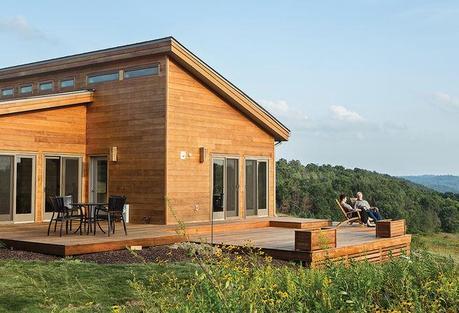
Karen Ellzey and Tim Wright gaze at the hills of Wisconsin’s Driftless Area from the deck outside their prefab house by Blu Homes. The Brant Natural Folding Chairs are from Crate and Barrel, and the Strata chairs and wrought-aluminum patio table are by Summer Classics.
Project Wisconsin Balance House Architect Blu HomesWhen you’re a grandson of Frank Lloyd Wright and planning to build near Taliesin—Wright’s studio and architecture school near Spring Green, Wisconsin—you have no shortage of design resources. Tim Wright, a documentary filmmaker who teaches at Taliesin, and his wife, Karen Ellzey, managing director for a commercial real estate firm, live in Boston but had a set vision for a flexible second home on a rolling hill seven miles from his grandfather’s estate. After consulting with several architects, they decided that a prefab house would best respect their plan for a flexible home that would sit lightly on the land, and they settled on Blu Homes, a start-up based in Vallejo, California, to execute it. Blu Homes’ steel-framed structures, manufactured in a factory north of San Francisco that once churned out nuclear submarines, fold out on hinges like a pop-up book. Wright and Ellzey chose the Balance model for its flexible floor plan, spacious interior, and modern design. Unlike some other prefabs, it didn’t resemble a “glorified trailer,” Wright says, and the company’s energy and drive were a draw. The components were trucked out on two semis in 2012 and assembled in seven and a half weeks. Wright and Ellzey’s house, Blu Homes’ first Midwest project, is a 2,984-square-foot statement in simple living that cost a relatively modest $475,000, including the foundation and the added 1,184-square-foot basement.
Tim Wright: We stopped right up by the big oak [at the entrance to the property], got out on that hill, saw the 14-mile view to Blue Mounds, and something went boing: We must have this land. So we got it, 112 acres, with no clue as to what we would do. That was March 2006. We didn’t build this until 2012. There was a long period where we would just drink wine on the hill.
Karen Ellzey: I felt very at peace out here. We wanted the ability to come out here and have a space to call ours, something flexible that could become a gallery or be a place for meetings. We actually had a few architects do drawings—Tim’s cousin Eric Lloyd Wright even tried to adapt an old sketch of an unbuilt Wright home. We all agreed it was a nonstarter. One day, I decided to check modular homes and came upon Blu. I saw this layout and it felt right. If I had sketched a floor plan, this would have been the one I wanted.
Wright: Blu doesn’t give you measurements in square feet because they believe you don’t live in square feet, you live in cubic feet. The interior is 1,800 square feet of interesting space. And when you see the 16-foot ceiling, it changes things enormously.
Ellzey: It really did kind of pain me a little bit that we’re doing this manufactured home instead of working with an architect. But when you go back to someone like Frank Lloyd Wright, he’s fundamentally interested in affordable homes for the average American. While we knew it would be a little controversial, it seemed like investing in this innovation path. In a sense, it’s the most Frank Lloyd Wright thing we could have done.
Wright: I’d describe this house as artisanal. Our furnishing concept is based on transformation, with a video projector instead of a TV, a dining room table that expands to seat 12, and mounting wires for blackout curtains or canvases, so we can easily entertain friends, show a documentary, or host an art exhibit.
Ellzey: When we visited the factory, we could see the two boxes side by side. The main space really appealed to me—you can get a real great sweep of the house. And Blu was flexible. They added two windows to the great room, since it was important for us to have a space that looked like a porch. All the architects in Tim’s family thought we chose the wrong site [facing the oak]. We fell in love with this view. As Tim said, the house wasn’t going to be the star; the landscape was going to be the star. This was just a way of accessing it.
[photo:2]
